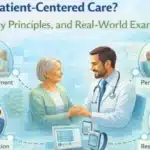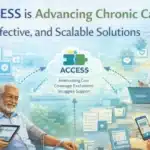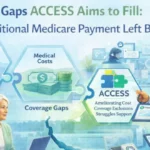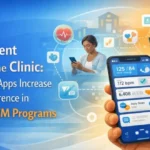Remote Patient Monitoring: 10 Game-Changing Applications Transforming US Healthcare in 2025
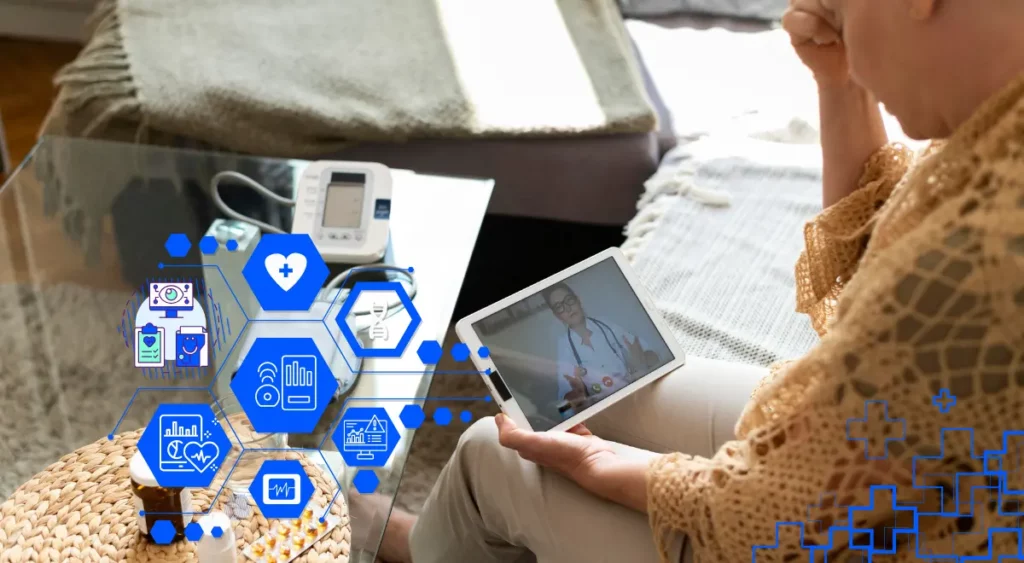
10 game-changing RPM applications that are improving clinical outcomes and helping providers unlock new revenue streams in 2025. Backed by real-world data, emerging policy support, and FDA-cleared technology, these solutions represent the future of value-based, patient-centered care.
Healthcare professionals across America are witnessing something extraordinary. Remote Patient Monitoring (RPM) has evolved from a niche technology to an essential infrastructure that’s reshaping how we deliver care. With 46.3% of U.S. hospitals now offering RPM services and Medicare reimbursement solidifying its financial foundation, this isn’t just another healthcare trend—it’s the future happening right now.
The numbers tell a compelling story. US RPM revenue reached $12.76 billion in 2024 and is projected to soar to $32.17 billion by 2032. That’s a robust 12.3% compound annual growth rate that reflects genuine clinical value, not just market hype.
But what does this mean for your practice? How can you leverage RPM to improve patient outcomes while capturing new revenue streams? Let’s explore ten evidence-backed applications that are delivering real results across the healthcare spectrum.
Table of Contents
ToggleUnderstanding RPM in Today’s Healthcare Landscape
Remote Patient Monitoring represents a fundamental shift from episodic care to continuous health management. Unlike traditional telehealth visits, RPM creates persistent connections between patients and providers through connected devices that automatically collect and transmit physiological data.
Remote patient monitoring devices work through a straightforward process:
- Sensors capture patient data (blood pressure, weight, glucose levels, etc.)
- Transmission layers (cellular or Bluetooth) send information to cloud platforms
- AI analytics identify patterns and flag anomalies
- Healthcare teams receive actionable insights integrated directly into electronic health records
What makes 2025 particularly exciting? The regulatory landscape has matured significantly.
CMS Reimbursement Framework
The Centers for Medicare & Medicaid Services now provides clear pathways for RPM reimbursement:
- CPT 99453 ($19.73): One-time device setup and patient onboarding
- CPT 99454 ($43.02 monthly): Device supply and data transmission (minimum 16 readings per 30 days)
- CPT 99457 ($47.87): First 20 minutes of clinical review and care planning
- CPT 99458 ($38.49): Additional 20-minute increments for complex cases
Federally Qualified Health Centers (FQHCs) and Rural Health Clinics (RHCs) gained eligibility for these codes in 2025, expanding access to underserved populations.
Remote Therapeutic Monitoring (RTM) codes 98975-98981 now cover medication adherence and rehabilitation services, creating additional revenue opportunities.
Market Momentum Drivers
Several factors are accelerating RPM adoption:
- Chronic Disease Burden: With 38.4 million Americans living with diabetes, nearly 14.7% of U.S. adults as of 2024 managing hypertension, the need for continuous monitoring has never been greater.
- Clinician Shortages: RPM helps stretched healthcare teams manage larger patient populations more effectively.
- Consumer Acceptance: Widespread adoption of wearables has made patients comfortable with health technology.
- Value-Based Care: Payment models increasingly reward outcomes over volume, making RPM’s preventive approach financially attractive.
Ten High-Impact RPM Applications
1. Hypertension Management: The Foundation of Cardiovascular Health
Hypertension affects nearly half of American adults, yet blood pressure control remains suboptimal in many patients. RPM is changing this reality through continuous monitoring and timely interventions.
Recent clinical evidence demonstrates impressive results. RPM programs reduce average systolic blood pressure by 11.9 mmHg in uncontrolled patients and up to 16.7 mmHg in those with stage 2 hypertension. Mean arterial pressure drops by an average of 8.5 mmHgWhat makes these results particularly noteworthy? Both primary care practices and FQHCs achieve comparable outcomes, suggesting RPM can help address health equity challenges.
Implementation typically involves cellular-enabled blood pressure cuffs that automatically transmit readings to clinical dashboards. Care teams establish thresholds for alerts and develop protocols for medication adjustments. The key is combining technology with a human touch—nurse-led coaching significantly amplifies clinical benefits.
2. Medication Management and Titration in Cardiology
Cardiovascular medications require frequent adjustments based on patient response, side effects, and changing clinical conditions. Traditional approaches rely on infrequent office visits and patient self-reporting—neither provides the granular data needed for optimal titration.
Smart pill dispensers and digital adherence platforms are transforming this process. These devices track when medications are taken, identify missed doses, and provide real-time feedback to both patients and providers.
The clinical impact varies by implementation model. Physician-directed RPM programs show moderate improvements in blood pressure and glycemic control compared to nurse-led approaches. However, the ability to catch medication errors early and adjust dosing based on physiological response creates substantial safety benefits.
Integration with electronic health records enables automated alerts when patients miss critical medications or experience concerning vital sign changes. This proactive approach prevents many emergency department visits and hospitalizations.
3. Congestive Heart Failure: Weight Monitoring That Saves Lives
Heart failure readmissions represent one of healthcare’s most expensive and frustrating challenges. Patients often deteriorate gradually, with fluid retention building over days before symptoms become apparent.
Daily weight monitoring through connected scales addresses this problem directly. When patients gain two or more kilograms within 24-48 hours, clinical teams receive immediate alerts enabling early intervention.
The evidence is compelling. Randomized controlled trials show 45% reductions in 30-day readmissions when RPM weight monitoring is combined with nurse-led follow-up protocols.
Implementation success depends on patient education and rapid response protocols. Patients need to understand why daily weighing matters, and clinical teams must have clear escalation pathways when alerts fire.
Clinical Workflow: Morning weights are transmitted automatically to dashboards. Threshold breaches trigger same-day nursing calls. Medication adjustments can often prevent hospitalizations that would otherwise occur 3-5 days later.
4. Obesity Management: Addressing America’s Health Crisis
With 42.4% of US adults being classified as obese, weight management represents a clinical imperative and sizable market opportunity. Traditional weight management efforts are generally based on intermittent weigh-ins and self-reported diet intake, both of which can be infrequent and unreliable.
RPM transforms the management of obesity and chronic disease with continuous weight tracking and the use of artificial intelligence (AI) to facilitate real-time behavior change interventions. With connected scales, patients can have objective and frequent measurements, and healthcare professionals can provide personalized suggestions for nutrition and physical activity through smartphone apps.
Our pilot studies have shown meaningful outcomes for participants in our RPM-enabled weight management programs. On average, participants in an RPM weight management program benefit from average weight losses of 5% over six months—5% is the threshold amount that is associated with clinically significant health benefits.
The technology extends beyond simple weight tracking. Some programs incorporate:
- Smart scales that measure body composition
- Activity trackers monitor steps and exercise intensity
- Food logging apps with barcode scanning capabilities
- Automated coaching messages based on progress patterns
Revenue opportunities include chronic care management billing and participation in obesity-focused value-based contracts.
5. COPD and Pulmonary Disease Management
Chronic Obstructive Pulmonary Disease impacts more than 16 million Americans and causes significant health care expenditures with multiple exacerbations and hospital admissions. RPM opens the door for earlier intervention and improved disease management.
Pulse oximetry monitoring is the core of most COPD RPM programs. Patients use fingertip devices that automatically measure oxygen saturation daily. Because declining oxygen levels often occur 24-48 hours before clinical symptoms develop, pre-emptively treating decreased oxygen levels leads to better outcomes.
The clinical outcomes are remarkable. In a pre-post study with 126 patients in a COPD RPM program, all-cause hospitalizations per patient-year decreased from 1.09 to 0.38, as well as a decrease of 44.3% in emergency department visits.
The technology landscape continues expanding. Electronic respiratory monitors for asthma patients improve symptom-free days by 25%. Remote spirometry enables monitoring of lung function trends in cystic fibrosis and bronchiectasis patients.
Key Success Factors:
- Patient education on device use and when to seek care
- Clear protocols for responding to oxygen desaturation alerts
- Integration with pulmonary rehabilitation programs
- Coordination between primary care and specialist teams
6. Diabetes and Continuous Glucose Monitoring
Diabetes management has been revolutionized by continuous glucose monitoring (CGM) technology. Unlike traditional fingerstick testing, CGM provides glucose readings every few minutes, creating comprehensive pictures of glycemic patterns.
The clinical evidence is robust across diverse populations. Medicaid youth participating in RPM-CGM programs saw hemoglobin A1c levels fall from 9.8% to 9.0%. Adult programs achieved even more dramatic results, with A1c dropping from 10.4% to 7.0% over six months.
A statewide RPM initiative spanning FQHCs, academic centers, and free clinics demonstrated sustained improvements: 1.8% A1c reduction at six months and 1.3% at twelve months. A 2025 meta-analysis of 20 randomized controlled trials confirmed an average 0.42% A1c reduction with RPM in type 2 diabetes.
What makes these results particularly significant? They were achieved across diverse healthcare settings and patient populations, suggesting broad applicability.
The FDA is pushing CGM adoption in hospital settings, recognizing its potential to improve inpatient glucose management and reduce hypoglycaemic events. This expansion creates new opportunities for RPM programs to extend from outpatient to acute care settings.
Implementation Considerations:
- Insurance coverage varies by device and indication
- Patient training on sensor insertion and app use is critical
- Data interpretation requires clinical expertise
- Integration with insulin pump therapy creates closed-loop systems
7. Post-Surgical Recovery: RPM from Hospital-at-Home to Enhanced Monitoring
Post-surgical care presents a critical window where complications often go undetected until they escalate. Remote Patient Monitoring (RPM) enables earlier detection of issues and allows patients to recover safely at home with clinical oversight.
Hospital-at-Home Programs:
Medicare’s Acute Hospital Care at Home waiver allows hospitals to deliver inpatient-level care in home settings while receiving full reimbursement. RPM devices such as Bluetooth-enabled vital sign monitors (blood pressure, heart rate, oxygen saturation, and temperature) are paired with tablet-based video consultations and clinical dashboards for real-time monitoring. In liver transplant patients, this approach reduced 90-day readmissions by 25% and improved pain control.
Enhanced Recovery Monitoring:
Beyond acute care, RPM supports surgical recovery through structured follow-ups. Patients use mobile apps to report pain levels, track mobility, and upload wound images via smartphone cameras. Wearable sensors provide activity data to assess recovery progress.
Clinical Impact:
Joint replacement patients using RPM programs report significantly lower 90-day readmissions and emergency visits. Structured pain reporting and medication adherence tracking also improve patient satisfaction and care continuity.
Key Implementation Elements:
- Daily transmission of vital signs and symptom data
- Wound photography reviewed by clinical staff
- Wearable activity trackers for mobility assessment
- Automated alerts for complications or delayed healing
- Integration with EHR for coordinated follow-up care
RPM in post-surgical recovery ensures patients remain connected to clinical teams, reducing complications and easing transitions from hospital to home.
8. Maternal-Fetal and High-Risk Pregnancy Monitoring
Pregnancy complications have a tendency to develop over time, and consequently, close and consistent monitoring is critical to early identification and intervention. Conventional strategies rely on multiple office visits that can be difficult for employed mothers or mothers living in rural areas.
The OB Nest model incorporates cellular blood pressure monitoring with telemedicine visits to limit travel burden while allowing for clinical oversight. The OB Nest model creates particular value in managing pregnancy-induced hypertension, which continues to be a key direct cause of maternal and fetal complications. The clinical outcomes are very promising.
Cellular blood pressure (RPM) reduced hypertensive hospitalizations by 50% for rural Medicaid mothers. Patient satisfaction scores significantly increased, while clinical outcomes were comparable to those cases utilizing traditional care models.
The technology extends beyond blood pressure monitoring:
- Fetal heart rate monitoring through wearable devices
- Weight tracking to identify concerning patterns
- Symptom reporting through mobile applications
- Educational content delivery based on gestational age
Medicaid bundled payment pilots are incorporating maternal RPM, creating sustainable financing models for high-risk pregnancy management.
9. Oncology Symptom and Toxicity Management
Treatment for cancer can have significant side effects that could result in delays in therapy, decreases in therapy dose, or hospitalizations. Conventional monitoring is done by having the patient describe their side effects at the scheduled visits, which can overlook important toxicities that occur between visits.
Electronic patient-reported outcomes (ePRO) combined with RPM devices can provide an effective means of comprehensive monitoring. The patient uses an app to document their symptoms, while the RPM device (e.g., digital pulse oximeter, smart scale) can provide objective physiologic measures.
Clinical trials and real-world studies have demonstrated that integrating electronic patient-reported outcomes (ePRO) with remote patient monitoring (RPM) can significantly improve symptom management, reduce hospitalizations, and enhance overall patient outcomes in oncology care.
The approach works particularly well for:
- Chemotherapy-induced nausea and vomiting monitoring
- Neutropenia detection through symptom tracking
- Cardiotoxicity surveillance with remote ECG monitoring
- Nutritional status assessment through weight trends
Clinician interviews reveal high usability scores despite initial concerns about workload increases. The key is implementing efficient triage systems that highlight patients requiring immediate attention.
10. Dementia and Cognitive Impairment Support
Nearly 7 million Americans live with dementia, creating complex challenges for medication adherence, safety monitoring, and maintaining independence. Remote monitoring technology presents opportunities to lessen caregiver stress and improve patient care quality through wearables, environmental sensors, and smart home systems.
Remote monitoring technology in Alzheimer’s disease care presents opportunities to lessen caregiver stress and improve patient care quality through wearables, environmental sensors, and smart home systems. These technologies address multiple safety concerns simultaneously while supporting independence.
The technology addresses multiple safety concerns simultaneously. Smart pill dispensers prevent medication errors, wearable GPS devices enable location tracking for wandering prevention, and activity sensors can detect falls or unusual behavior patterns that may indicate health deterioration.
Clinical Benefits:
- Improved medication adherence through automated reminders and dispensing
- Early detection of cognitive decline through activity pattern analysis
- Enhanced caregiver support through real-time alerts and status updates
- Reduced emergency interventions through proactive monitoring
- Extended independent living through comprehensive safety oversight
Future Trends Shaping RPM Evolution
The RPM landscape continues to change quickly, driven by technological advancements and shifts in healthcare economics. The following trends will shape the next stage of growth.
Artificial Intelligence and Predictive Analytics
Today’s RPM systems react to abnormal readings. Newer generation platforms will predict clinical deterioration before it clinically occurs. A recent survey has shown that introducing AI in RPM devices has reduced hospital readmissions by up to 30%.
Machine learning models trained on large patient databases are able to find subtle patterns that are too difficult for a human to detect. The use of predictive algorithms means the development of truly preventative interventions instead of early reactive care.
5G and Edge Computing Revolution
Network latency currently constrains real-time clinical decision support. 5G networks applied through edge computing will decrease sensor-to-EHR transmission times to less than 100 milliseconds to send immediate alerts for conditions leading to life-threatening situations.
This will usher in completely new applications such as real-time detection of cardiac arrhythmias and promptly adjusting medication dosages based on patient physiological response.
Regulatory Expansion and Policy Support
CMS is still expanding RPM’s coverage and reimbursement rates. The Hospital-at-Home waiver program will likely become a permanent fixture in the reimbursement system, which ensures a measure of stability for more advanced RPM applications.
Regional Congressional proposals for “clinician force multiplier” programs could provide more funding to RPM projects that demonstrate improved access to care for underserved populations.
Wearable Technology Integration
Consumer wearables such as the Apple Watch and Fitbit are rapidly receiving FDA clearances for a growing number of medical uses. The NeuroRPM application provides real-time tracking of Parkinson’s disease symptoms, and smartwatch-based motor exams strongly correlate to clinical assessments.
Future developments will likely include:
- Implantable sensors for continuous monitoring
- Smart contact lenses measuring intraocular pressure
- Patch-based devices monitor multiple biomarkers simultaneously
- Integration with smart home systems for environmental health monitoring
Frequently Asked Questions (FAQs)
RPM utilizes advanced healthcare technology to gather and stream pertinent health information such as blood pressure, weight, glucose, and even oxygen levels via connected devices. This data is then sent to the relevant healthcare providers, ensuring that care is being delivered even outside the clinic.
By 2025, RPM applications that will have the most impact focus on the management of hypertension, heart failure, and diabetes; medication adherence; post-surgical care; maternal and diabetes care; as well as oncology. These applications have all demonstrated added value from both clinical and economic perspectives based on proven clinical outcomes.
RPM is reimbursed by CMS under the Remote Patient Monitoring CPT Codes 99453, 99454, 99457, and 99458. Furthermore, RTM has additional CPT codes 98975-98981. Once FQHCs and RHCs became eligible in 2025, RPM became available to a greater number of underserved patients.
RPM programs measure blood pressure and monitor heart rates with Bluetooth-enabled blood pressure cuffs and smart scales, pulse oximeters, and even glucose monitors, all handheld. They also integrate with mobile applications and dashboards. Devices that are less active include digital pill containers, ECG patches, and glucose monitors. All of these devices are FDA-approved measures.
Complications can be avoided with early intervention thanks to the continuous data that is monitored. For instance, the utilization of RPM for heart failure has mitigated 30-day readmissions by as much as 45%, and some programs for COPD monitoring have reduced emergency visits by over 40%.
Certainly. There is evidence of 1 to 3% reductions in A1c in diverse populations with the use of RPM for glucose monitoring. Furthermore, RPM for hypertension has reported a reduction in systolic pressure by 16.7 mmHg, more so with coaching and medication adjustment.
Certainly. RPM can assist with the monitoring of vitals, pain levels, and mobility during the postoperative phase, leading to better readmission rates, improved pain management, and more effective recovery tracking in hospital-at-home or enhanced recovery postoperative pathways.
RPM facilitates distant monitoring of maternal blood pressure, weight, fetal heart tones, and other crucial symptoms. A 2025 study uncovered that programs employing cellular BP monitors for rural Medicaid mothers significantly reduced hypertensive hospitalizations by 50%.
Indeed. Patients suffering dementia can be aided by wearables, GPS trackers, smart pill boxes, and motion detectors that better monitor compliance and supervision, foster greater autonomy and safety, and diminish emergency incidents.
RPM adoption is driven by the chronic disease burden, clinician shortages, value-based care paradigms, consumer acceptance of technology, and stronger CMS reimbursement. The U.S. RPM market is expected to increase from 12.76B in 2024 to 32.17B by 2032.
HealthArc’s RPM tracks key respiratory metrics in real time, helping detect issues early, improve adherence, and personalize care — learn more here: The Way Remote Patient Monitoring Changes Pulmonary Care.
Ready to Move from RPM Theory to Practice? HealthArc’s Integrated Approach Eliminates Common Barriers
These ten applications highlight RPM’s clinical and financial opportunities; however, proper execution requires alignment with a technology partner and supporting structure. HealthArc, as a company, offers fully integrated RPM solutions that remove typical barriers such as device interoperability, complex billing scenarios, etc.
We serve over 25,000 patients within 50,000 provider organizations, processing everything from cellular-enabled devices to 24/7 clinical monitoring and electronic health record integration.
Whether looking to implement RPM for heart failure patients, Diabetes management, or post-surgical monitoring, the objective is to start with a targeted approach and then grow based on the outcomes.
Schedule a consultation to discuss which applications would be best suited for your patient population and practice objectives, or call 201-885-5571 to connect with our clinical team about implementation approaches.
Most Recent Blogs
Categories
Related Blog
- November 26, 2025 | Read Time: 14 mins
Return on Investment (ROI) of Remote Patient Monitoring (RPM): A Complete Guide for ACOs and Healthcare Organizations
The U.S. healthcare system continues its transition from fee-for-service models to value-based...
Learn More- November 24, 2025 | Read Time: 15 mins
Common RPM Pricing Models for Providers: A Profitability-Focused Guide
Remote Patient Monitoring (RPM) has rapidly emerged as one of the leading...
Learn More- October 23, 2025 | Read Time: 12 mins
How RPM Devices Improve Hypertension and Diabetes Outcomes in Medicare Populations
Remote patient monitoring (RPM) is transforming chronic care for Medicare beneficiaries. CMS...
Learn More